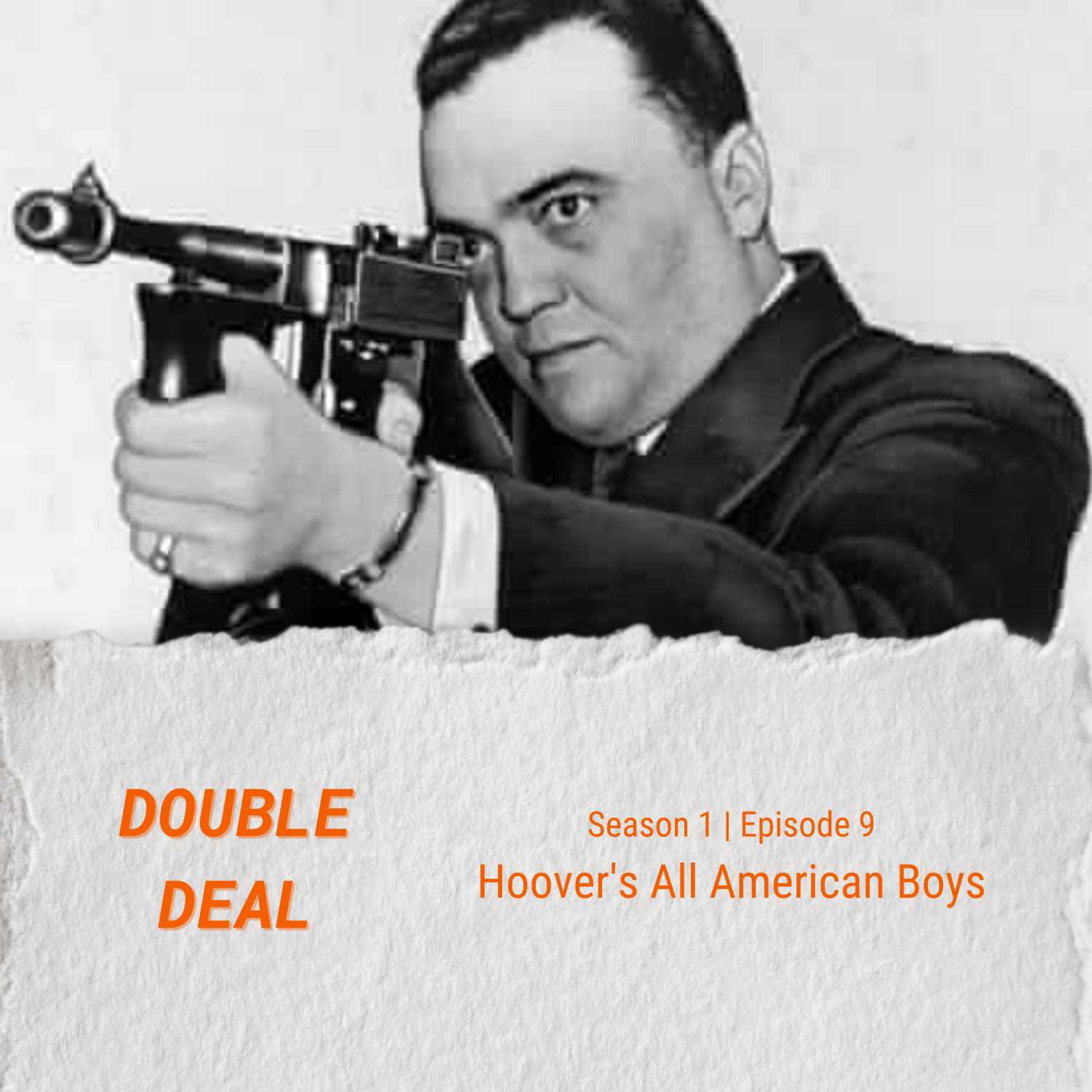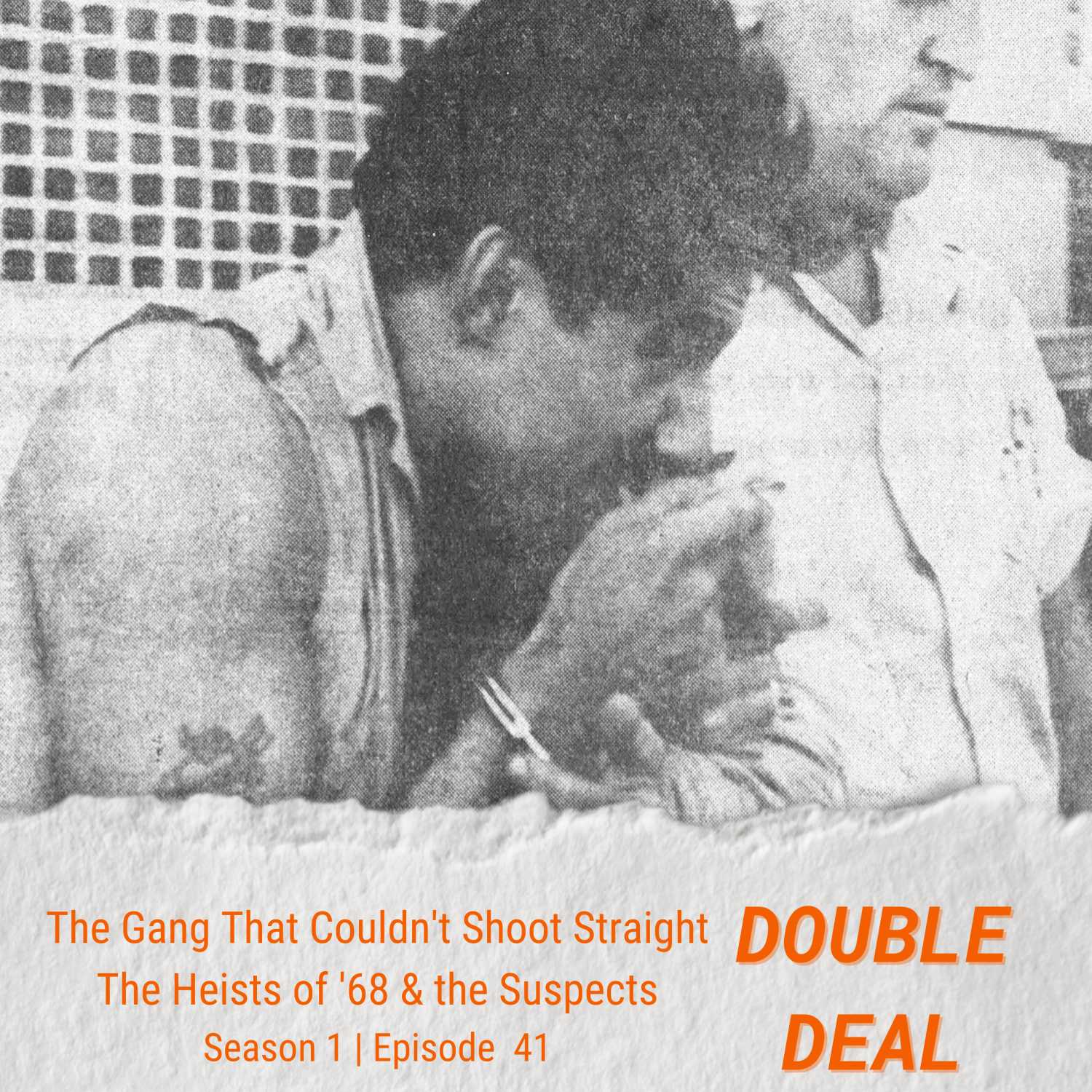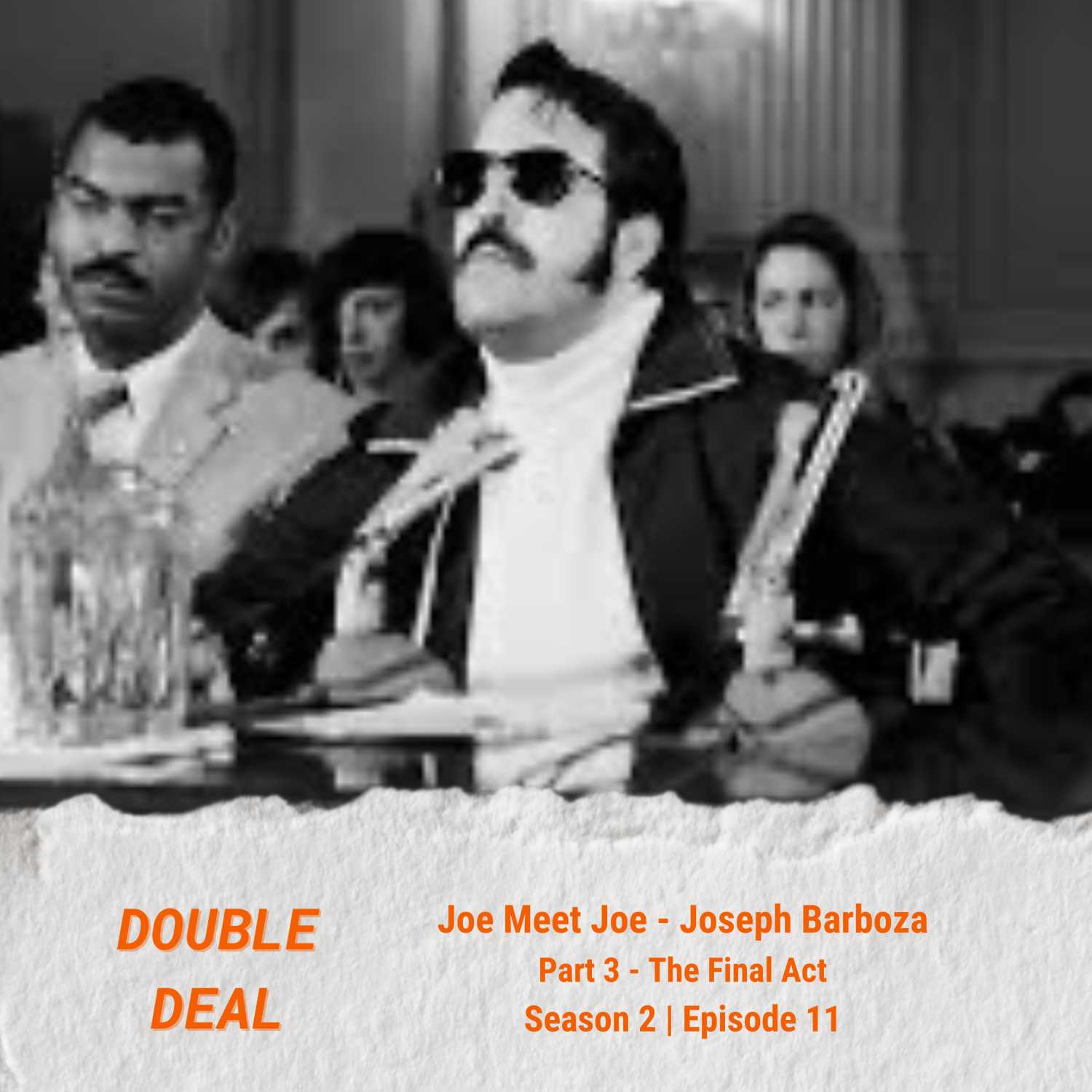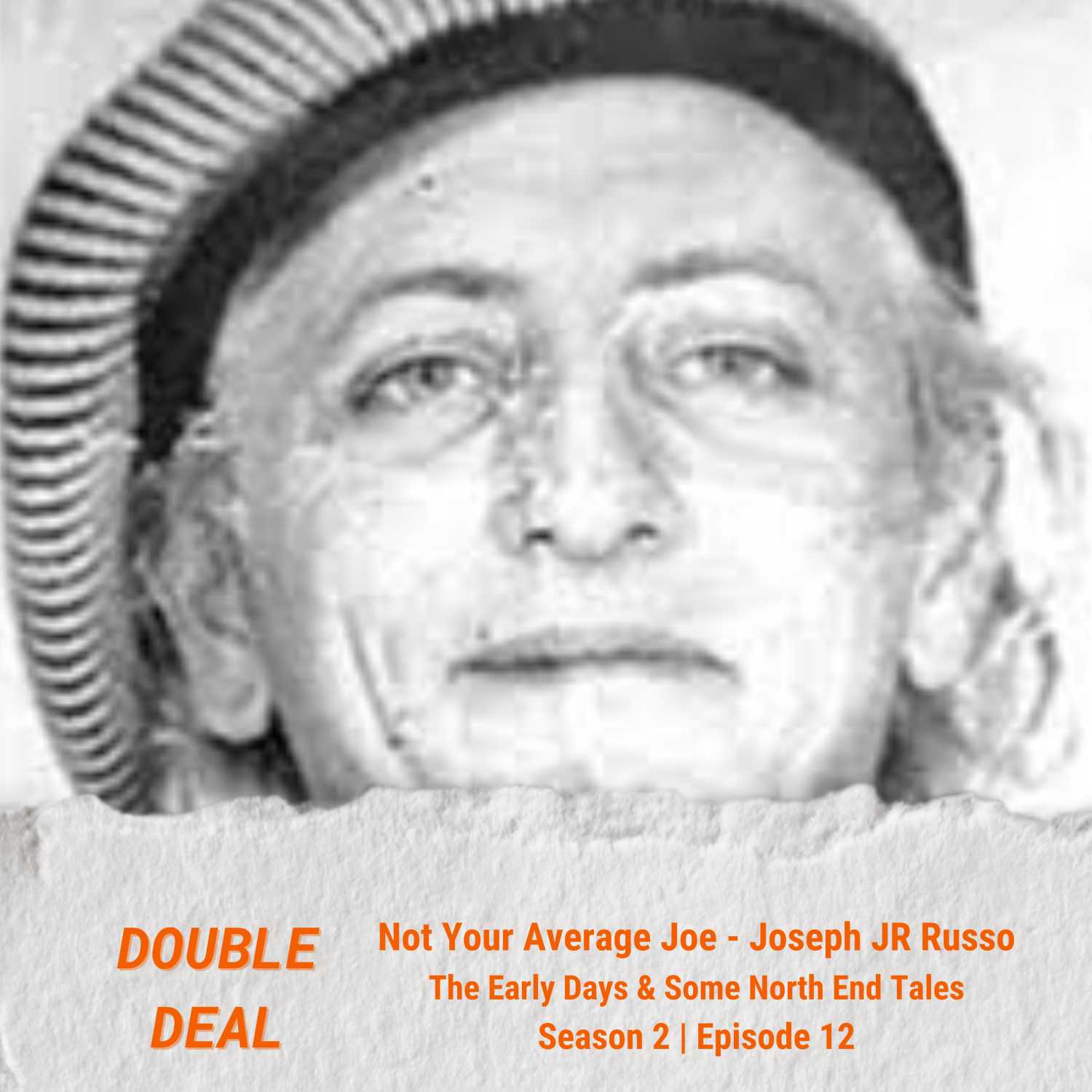Hoover's All American Boys

Meet the men of the Boston FBI office who comprised the special task force that was created to solve the Great Brink's Heist of 1950. Five of these men would go on to form the organized crime task force charged with bringing down the Mafia in New England.
Follow us on Twitter for sneak peeks of upcoming episodes. You can also find us on Instagram and Facebook. Our shop is up on Tee Public.
Questions or comments, email lara@doubledealpodcast.com or nina@doubledealpodcast.com
Thank you for listening!
All the best,
Lara & Nina
Lara:
Hi all! Thank you for listening. Nina and I are back to talk about the agents in the Boston FBI office in the 1950s and ‘60s. 5 of the 8 agents we’re discussing today comprised a special task force team initially created to solve the Brink’s case. It was headed by SA Edmund McNamara who we introduced in episode 1. SA John B. Greene will be making a comeback later in season 1, but not as a Fed!
Nina:
SA John Kehoe will also be rejoining us at various points in the future. According to Vinnie Teresa’s memoir, Kehoe persuaded Vinnie to become the government’s star informant.
Lara:
Yeah, star informant alright! Star liar is more like it. And let’s not forget Kehoe was stuck monitoring the wiretap at Raymond Patriarca’s office for the majority of the time. Talk about mind numbing. I had a lifetime of listening to similar conversations. “So you remember that guy from over there?” “You mean that guy on the corner?” “No, not that guy. The guy up the street from there. You know the guy who did that thing the other day.” “The guy who did that thing on Monday?” “Yeah, yeah that guy.” Oh fuck, you’d need a bottle of aspirin or vodka to listen to that on the daily. Alright, Nina, since this episode is your brainchild, I’ll let you lead.
Nina:
Before we get into the personalities that occupied the Boston FBI Office, I think we should talk a bit about the workplace culture.
If you had entered the FBI offices on the tenth floor of the Sheraton Building in 1956, you would first have seen a large framed photo of Director Hoover and his staff. Near that photo was another framed photo of Hoover’s favorite prose:
“Loyalty
If you work for a man, in heaven’s name work for him: speak well of him and stand by the institution he represents.
Remember -- an ounce of loyalty is worth a pound of cleverness. If you must growl, condemn, and eternally find fault, why, resign your position and when you are on the outside damn to your heart’s content: but as long as you are a part of the institution do not condemn it: if you do, the first high wind that comes along will blow you away, and probably you will never know why.”
When you first read that quote it sounds like something you’d read in a turn of the century reader or William Bennet’s “Book of Virtues”. Old-fashioned, Victorian, naive. It seems out of place in a law enforcement office.
Lara:
Do you think the agents tried to uphold that? I mean to be that loyal to each other.
Nina:
It was more about loyalty to the Institution. But not only. It was loyalty to Hoover himself. Criticisms were not tolerated. If you didn’t like the workplace culture, you got out, or were forced out. I’m thinking of SA Gerard Comen here as I say this. We will be telling his story later in the season.
But the Special Agents did look after their own. Even decades later, the idea of criticizing the FBI as an Institution was viewed as anathema by former employees. That attitude extended to colleagues as well.
Lara:
Sort of like a mother who thinks her child can do no wrong.
Nina:
Yes, but to take it a step further, the ends justified the means always. The successful resolution of a crime no matter the cost, either money or lives, it didn’t matter. Some cases were never prosecuted. Others were like the Brink’s case. The Feds zeroed in on a person or persons. And that was it. Laser-focused to the end.
Lara:
But that attitude left countless people incarcerated for crimes they didn’t commit.
Nina:
No question. And the true perpetrators were allowed to roam the streets and not only commit crimes of a financial matter, but murder.
This attitude informed decisions that were made for decades, and as we’ve said before, the impact can still be seen today.
As we go on in the series, you’ll see more of how this played out in practice.
Lara:
Sad to say, far too many times. Back to the men we’re discussing today. Nina, I think you said you want to discuss Edmund McNamara first. For those of you who listened to episode 1, you will remember that SA McNamara was responsible for the first and only conviction of Richie’s mentor, Jack Kelley. I’d encourage you to go back and listen to that episode if you haven’t already.
Nina:
Edmund Leo McNamara was born in Boston on April 13, 1920 to Michael, a fireman, and Catherine McNamara. He was the third of six boys. Edmund starred as tackle for Holy Cross grid squads in the early 1940s, later going on to the professional ranks with the New York Giants, Pittsburgh Steelers, and Providence Steamrollers. During World War 2 he commanded motor torpedo boats in the Pacific and was awarded the Silver Star for gallantry in action. He ended the war as a Navy Lieutenant.
Lara:
Pro ball player and war hero! But McNamara wasn’t the only football player in the group right?
Nina:
Nope! Ernie Schwotzer was born in Brockton in March 1917 to Rudolph and Louise Schwotzer. He attended Waltham High, went on to St John’s Prep, and finally Boston College, where he graduated in 1940. He was the team captain of BC’s football team his Senior year. The team lost the Cotton Bowl to Clemson that year.
Lara:
I’m going to piss some people off here for sure with this comment, but Clemson seems to always be the better of the two teams. Don’t troll me over that! Hey, wasn’t there a baseball player in the bunch too?
Nina:
Yes, Buck! Ronald J “Buck” Weafer was born 22 July 1910 to Jeremiah and Margaret Weafer. Buck graduated from Boston University with a degree in Business Administration in 1932. He went on to get a law degree from his alma mater in 1934. He was captain of the hockey team his senior year.
But Buck’s true passion was baseball. It was a family tradition. One brother was an umpire for decades, and another played for Albany in the late 30s. Weafer was signed on with the Philadelphia Athletics just after he graduated law school.
Lara:
Double letter boy! Hey, didn’t Kehoe play hockey?
Nina:
Yes! John Francis Kehoe Jr was born on 17 Oct 1919 to John F Kehoe and Emma O’Connell. He was the captain of the Boston College High School hockey team his senior year. Kehoe went on to graduate from Boston College in 1941. He also got his private pilot certification while there.
Lara:
Flying hockey player! What about John B. Greene?
Nina:
John Bertram Greene was born in December 1910 to Michael and Alice Greene. His father’s side of the family were some of the original settlers of Tilting, Newfoundland dating back to the early 1700s. He graduated from Dorchester High School and went on to get a law degree from Northeastern in 1932.
Lara:
More than a few of them had law degrees. Larkin did too right?
Nina:
John Paul Larkin was born on 21 October 1915. He graduated from Boston University and then Suffolk Law.
Lara:
Nothing too exciting about Larkin's younger years..
Nina:
Well, not until we get into his FBI career.
Lara:
Tell us about Frisoli?
Nina:
Leonard Frisoli was born in November 1916 to Lawrence and Antonetta Frisoli in Cambridge.
He graduated from Boston College with a Bachelors of Science degree in Education in 1941.
Lara:
Another boring back story. And last but not least Edward Powers.
Nina:
The outsider. He’s the only one who wasn’t a local. Ed Powers was born in August 1913 to Edward J Powers Sr, a Chicago police detective sergeant, and his wife Ruth. In 1936, Ed Powers got his degree in accounting from Lawrence College in Wisconsin. He was Phi Beta Kappa. His mentor at college was the future president of Harvard. Powers worked in insurance for a while after graduating. He did not play ball himself, only golf.
Lara:
Loner!!!!
Nina:
He was also an expert marksman. Once, after giving a speech at a law enforcement academy he was egged on to come to the firing range and give a demonstration. Using a pistol, he fired in front of the crowd from every distance and position - standing, kneeling, laying prone - and scored 99 out of 100.
Lara:
Talk about a show off! Man after my own heart!
Nina:
I’ve titled this episode as a nod to Specky O’Keefe who once referred to Ed Powers as “one of those all-American guys”.
Lara:
Well, it's accurate. Now that we know a little bit about their early years, tell us about how they became a team.
Nina:
McNamara headed the team that handled the Brink’s case. He joined the FBI in 1942 after a brief stint with the US Rubber Company that he got through his college football coach, Frank Leahy. He also played briefly in the revived short-lived semi-pro team, the Providence Steamrollers.
J Edgar Hoover described McNamara as “alert, diligent, aggressive, and skilled”.
Lara:
Remember that McNamara goes on to be the Police Commissioner of Boston for a decade after leaving the FBI. He definitely was a dedicated law enforcement officer. Wasn’t John Greene already in the Boston office when Mcnamara came on?
Nina:
I’m not entirely sure when Greene came back to Boston. He went into private practice in Boston for several years after he graduated from Northeastern law school. He joined the FBI in 1938. He served in various FBI offices around the country before returning to Boston.
You may recall him from our previous episode on the Brink’s case. Greene was the one who swore out the affidavits for the warrants to search Specky O’Keefe and his sister’s residences in 1950. And he was Rico’s supervisor in 1962. Greene retired from the FBI soon after that incident and went back into private practice.
Lara:
As I mentioned at the beginning Greene will be returning later in the season, but this time as defense counsel for some of the very men he had been trying to arrest over the years.
Nina:
Next we have John F Kehoe. He applied to join the FBI straight out of college. His draft card has the address of the FBI penciled in across the top. He was stationed in New York City among other locations before returning back home to Boston in 1947.
Lara:
I know you think that Kehoe got the bum end of the stick all the time because he was always the one prying off a wall panel or the first one through the door, but since I see a bit of my own character in that, I have to disagree. He volunteered! He wanted to be the one to step up before everyone else. I can see him screaming, “NO, NO, I’ll do it, let me do it!” That’s me all the way! Not because we think we’re better, but we don’t want to wait around while someone else fucks it up!
Nina:
Oh please! You guys do think you’re better and more capable than the rest of us!
Lara:
Hey, watch it, I resemble that remark ;)
Nina:
The more I think about it, the more I think you are right about his character. A 1971 article in the Boston Globe noted that Kehoe received 60 letters of commendation over the course of his 29 year FBI career.
Lara:
He was after the kudos!
Nina:
So it would seem. He was also the first one in the door when they went to arrest George O’Brien in the Danvers case.
Lara:
Poor George O’Brien, he should have stuck with gambling. He was a lousy thief.
Nina:
At least Kehoe didn’t have to use any of his sports moves on him. Next we have John Paul Larkin. He applied to the FBI in 1941. According to his draft card he was working for Sears Roebuck at the time. He was first sent to New York City. But eventually he was stationed in Costa Rica and Venezuela during some portion of World War 2. His oldest child was born in Caracas.
Larkin was on the Brink’s team from the night of the heist on January 17, 1950. He had grown up in the same neighborhood as the suspects.
Lara:
You really couldn’t find any early stories about Frisoli, Weafer and Schwoetzer’s careers?
Nina:
Well, Buck Weafer’s baseball career seems to have been short lived. By 1940 he was in private law practice with an older brother, Leonard. And it doesn’t look like he served in the War either.
Frisoli joined the FBI in February 1942. The only reference to Frisoli that I could find in the newspapers prior to the Brink’s case was when he and a fellow agent were able to rescue twin boys who had been thrown out the window of a burning building in Cambridge by their mother.
Schwotzer taught firearms courses to local cops throughout the 1940s and continued the tradition even after he retired in the 1960s.
Lara:
Sharpshooter Schwotzer! To round out the team, there was Ed Powers, the Special Agent in Charge.
Nina:
Powers joined the FBI in 1941. He started his career in New York City, and then got sent to San Antonio. He was soon sent to DC where he worked at headquarters and took night classes to get his law degree from Georgetown. In July 1945 Hoover tasked Powers with overseeing his personal campaign against the Communist Party of the USA. As a reward for his success, Ed Powers was made Assistant Special Agent in Charge in Pittsburgh, and then Minneapolis. He was then put in charge of the Miami office.
Lara:
How many Commies could have been hanging around in Miami?
Nina:
Well, there actually was a story about that, but I didn’t want to get into it here because it didn’t seem relevant to our story. Another time, though.
Lara:
When we start our next series about JFK - Spies and Wiseguys, we’ll revisit that story for sure.
Nina:
By late 1954, Hoover was getting frustrated with the slow progress of the Brink’s case. Specky O’Keefe was in jail but was still uncooperative. Hoover knew he could rely on one person to get the job done. In early December, Ed Powers arrived in Boston, the sixth SAC post-Brinks. He also had a brand new office on the tenth floor of the Sheraton Building. One month later, Ed Powers was quoted as saying: “The FBI is still working on the Brink’s case to develop leads in order to bring the case to a successful conclusion.”
Lara:
Conclusion! What about actually solving the crime?
Nina:
Meh! Solving Crimes is for Suckers! Tee shirt!
Lara:
That reminds me our Tee Public shop is up! Link in the show notes! Ok enough pandering. Tell us about some of their crime fighting adventures.
Nina:
You might recall that Ed Powers and John Larkin were the two Special Agents who convinced Specky O’Keefe to become their star witness. Specky wasn’t the only government witness during the two-month long trial, though. McNamara’s team all got their chance to shine on the stand. Kehoe testified that he alone had interviewed more than 1,000 people over a six and a half year period.
Lara:
See! Glory seeker!
Nina:
Over 6,000 people were interviewed during that period by the FBI, so his estimate is probably about right. But now I want to tell the story that inspired this episode.
In May 1956, the last two Brink’s suspects were arrested in an apartment on Coleman Street in Dorchester. Boyhood friends Sandy Richardson and James Faherty had been on the lam since January. But they weren’t placed on the FBI’s Most Wanted List until April.
Lara:
Ahhh! I was hoping you were going to tell that story.
Nina:
Slow down! I’m getting there. Supposedly, a longshoreman named William Cameron tipped off the Feds as to the fugitives’ location. He was linked to Tommy Callahan and Tommy Ballou, who were the ones keeping Richardson and Faherty housed and fed. Remember from the Moldy Loot episode that Jordan Perry had once used the name “Tommy Ballou” as an alias.
Cameron claimed that he had been the one to rent the apartment in Dorchester for the fugitives, but that he had never been paid for his services. As revenge, Cameron ratted. A month later, Cameron was found slumped over the steering wheel of his car, two .38 caliber slugs in his face. Tommy Callahan was arrested for Cameron’s murder, but the authorities couldn’t make the charges stick. Tommy Callahan will be joining us again in future episodes.
Lara:
Tommy Callahan meets a fate worse than two bullets. And Ballou didn’t make out too well in the end either.
Nina:
We will get into all of that later in the season.
The FBI staked out the Dorchester tenement to see which unit was getting food delivered by Ballou. Powers and his men created an elaborate operation to secure the building before going in. With some agents dressed as custodians and others tenants, they surrounded the apartment and had every door and window covered. A team of about a dozen agents went to the door, pistols drawn, and battered their way in.
Powers was first in the room!
Lara:
He beat Kehoe! Told you he was a show off.
Nina:
It took seven former sports stars and their colleagues to take down two fugitives from justice who were in the middle of choking down Dinty Moore beef stew, and rolling $5000 worth of coins into paper packages.
Lara:
I have this visual of Sandy and Faherty with two rusty cans of Dinty Moore and the feds barging in!
Nina:
I told you! It’s hilarious!
On the stand, Schwotzer recalled that when the FBI men burst into the second-floor apartment, Richardson dashed for the bathroom, but was grabbed by Special Agent Kehoe. Schwotzer said he took Richardson “under control” and that Kehoe then pursued and grabbed Faherty.
Lara:
Oh to be a fly on the wall!
Nina:
Kehoe later described his tackle as “a lunge” when questioned by defense attorney Lawrence O’Donnell in court. Kehoe said he left his feet in the grab to prevent Faherty from reaching the three revolvers that were on a chair under a towel in the bathroom.
Lara:
If you were on the lam would you have three pistols on a chair in the toilet?
Nina:
And stashed under a towel! Buck Weafer later testified that he had found a bottle of hair dye in the bathroom medicine cabinet. Sandy Richardson had colored his hair brown in an attempt to disguise himself. His hair was normally a white blonde, which is why he was called “Sandy”.
Another agent testified that he commented to Richardson, “I thought you were a little white-haired old man. What happened?”
“I dyed it,” Richardson replied.
“I thought you once told me that if I ever came to arrest you, all I had to do was ring your doorbell. Instead you were in your apartment with guns, and you’ve got a reception committee waiting for us.”
Richardson responded, “Well you know how it is, Mac.”
Lara:
Then what happened?
Nina:
The two fugitives were hustled into the kitchen by Schwotzer and Kehoe. As they held them, Kehoe shouted to Weafer, “There’s guns in the bathroom, Buck!”
Lara:
When I hear “Buck” I think of the Little Rascals or something! Fucking grown man nicknamed Buck.
Nina:
Oh, I remember watching those as a kid! But that kid’s name was Buckwheat. But Buck seems to be a popular nickname for jocks.
When the Brink’s case finally went to court in September, the Feds leaked to the press that Kehoe wrenched his back in the tussle with Sandy and Faherty.
Lara:
Serves him right!
Nina:
It couldn't have been that bad, though, because he had no problem getting down on his hands and knees to get the moldy loot out of the wall at Wimpy’s place the following month!
Lara:
I still like to think that Rico was standing off in a corner aloof like a cat looking upon Kehoe with disdain as he labored away removing the wall panel!
Nina:
Can you imagine?!
Just one more tidbit to kind of wrap up the Brink’s case, Ed Powers sat beside District Attorney Garret Byrne for the entire two months of the Brink’s trial. Reminds me of a future case that we will be covering much later in the season.
Lara:
So what happened to the team after the Brink’s case was closed?
Nina:
The task force that McNamara headed was formed for the sole purpose of resolving the Brink’s case. But once that job was completed in 1956, the team was not dissolved, but rather rebranded and became devoted to rooting out Organized Crime. Eventually it was expanded to cover Massachusetts, Maine, New Hampshire, and Rhode Island. All of New England except Connecticut, which fell under New York’s jurisdiction. Your glory hound, Kehoe, was heading it then.
Lara:
From the early 1930s until 1957, J Edgar Hoover had insisted that there was no such thing as La Cosa Nostra or national organized crime. He insisted the mob only operated at the local level.
Nina:
So they created a bogey man to fight. McNamara’s team needed a new task to focus on.
Lara:
Well, there were more than enough crimes to keep everyone busy. As The 50s rolled into the 60s there were nearly 100 gangland slayings in and around the Boston area. Add to that the number of armed robberies of banks and armored trucks, and there was no need to “create” anything.
Nina:
You don’t have to tell me. Remember I’m the one who compiled the spreadsheets of informants, murders, and crimes for this podcast and our book.
Lara:
On that note, I think it’s time to call it quits. Nina’s reminding me of all of her hard work. Means she might start to get nasty!
Nina:
You’re really trying to give people the wrong idea about me!
Lara:
Hey people need to know what I’m dealing with here. You know I’m just teasing you!
Next week we will be discussing dad’s release from prison, his arrest for Fats Buccelli’s murder, and how he became an informant for the FBI.
I’ll spare you the plugging today. Just check out the show notes, please leave a review wherever to us and share an episode with your friends!
Thank you all for listening!
Nina and Lara:
Bye!


































